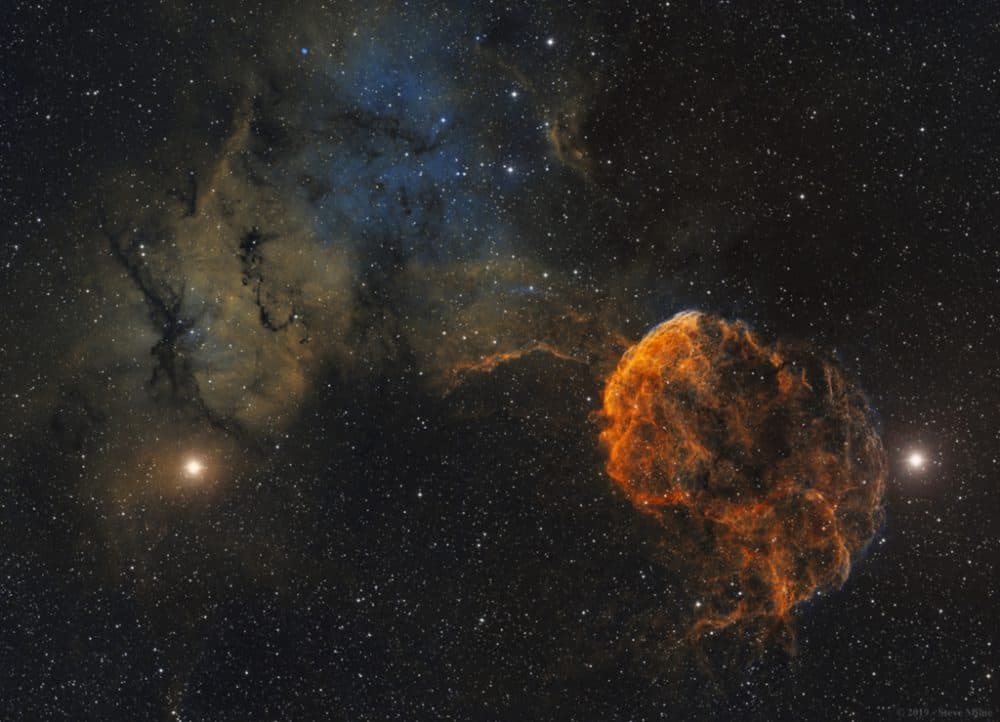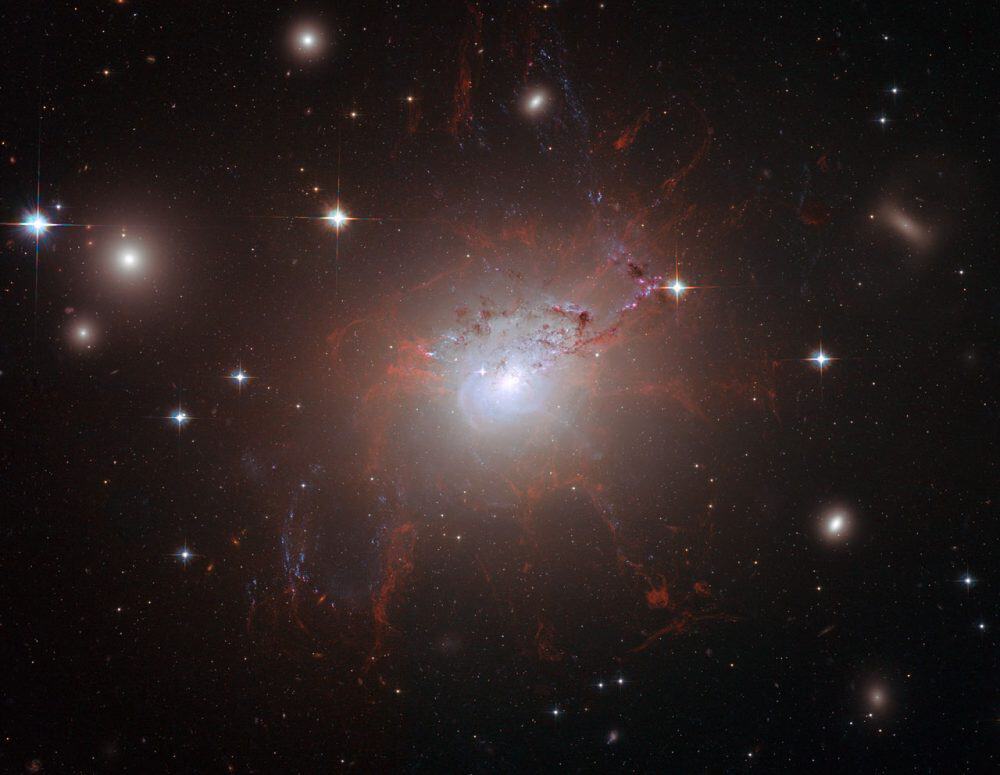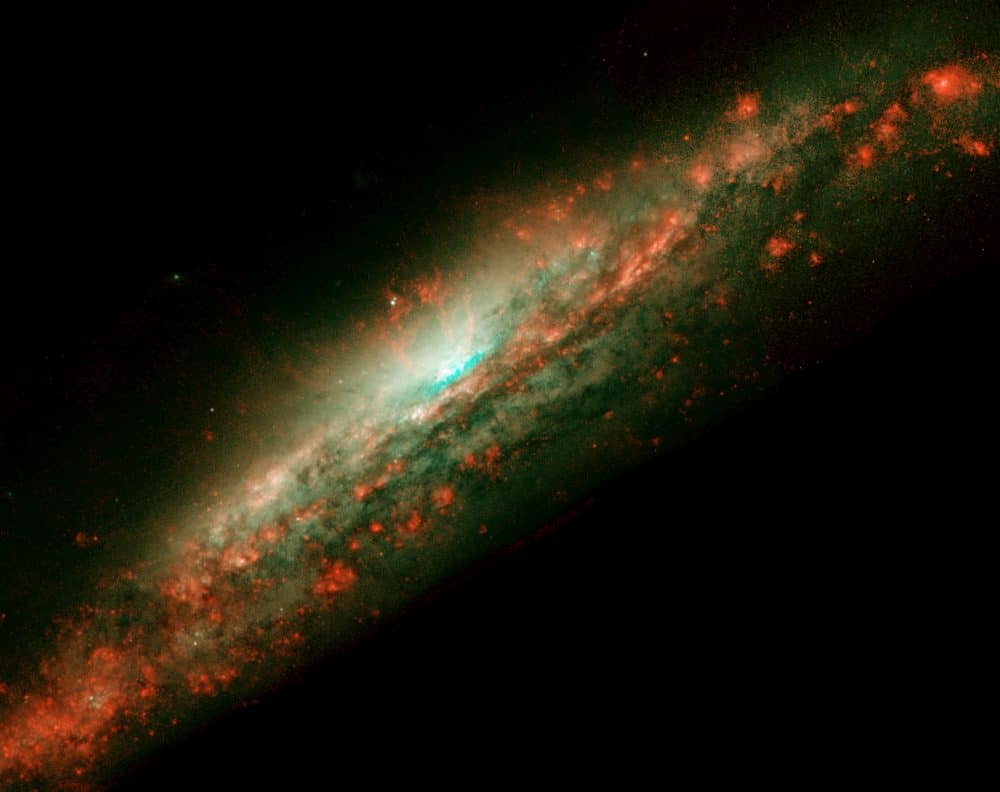Blog
World Music on Flamenco Fridays featuring Bulerias
more...Normally faint and elusive, the Jellyfish Nebula is caught in this alluring telescopic field of view. The entire scene is a two panel mosaic constructed using narrowband image data, with emission from sulfur, hydrogen and oxygen atoms shown in red, green and blue hues. It’s anchored right and left by two bright stars, Mu and Eta Geminorum, at the foot of the celestial twin. The Jellyfish Nebula itself is right of center, the brighter arcing ridge of emission with dangling tentacles. In fact, the cosmic jellyfish is part of bubble-shaped supernova remnant IC 443, the expanding debris cloud from a massive star that exploded. Light from the explosion first reached planet Earth over 30,000 years ago. Like its cousin in astrophysical waters the Crab Nebula supernova remnant, the Jellyfish Nebula is known to harbor a neutron star, the remnant of the collapsed stellar core. An emission nebula cataloged as Sharpless 249 fills the field at the upper left. The Jellyfish Nebula is about 5,000 light-years away. At that distance, this image would be about 300 light-years across.
more...Dan’s repertoire consists of originals and jazz standards, his music is the opposite of where the mainstream jazz sound is today.
Louis Albert Cottrell Jr. (March 7, 1911, New Orleans – March 21, 1978, New Orleans) was a Louisiana Creole jazz clarinetist and tenor saxophonist. He was the son of the influential drummer Louis Cottrell, Sr., and grandfather of New Orleans jazz drummer Louis Cottrell. As leader of the Heritage Hall Jazz Band, he performed at the famous Carnegie Hall in 1974.Louis Cottrell was born into an upper-class Creole musical family. His father, Louis “Old Man” Cottrell, Sr., was a famed drummer, and cornetist Manny Perez was his godfather. The young Cottrell grew up around such great musicians as Barney Bigard, John Robichaux, and A.J. Piron. Cottrell studied clarinet under Lorenzo Tio Jr. and Bigard. He began his career in the 1920s with the Golden Rule Orchestra, and then in 1925 played with Paul “Polo” Barnes. Later in the 1920s he worked with Chris Kelly and Kid Rena, then in 1929 found work on the riverboat SS Island Queen with Lawrence Marrero‘s Young Tuxedo Brass Band and Sidney Desvigne. These were the years when he became a prominent union organizer. He joined Don Albert‘s orchestra soon after, recording an album with the orchestra in 1935 under the Vocalion label. He tried his hand at composing, and with Lloyd Glenn and Albert wrote, “You Don’t Love Me (True).” Rhythm and blues bandleader Paul Gayten would later approach Cottrell to record “You Don’t Love Me” and it became one of the first hits of the R & B New Orleans era, having made it to the number 5 spot nationally on the R & B top ten charts. Cottrell toured widely throughout North America with Albert until 1939.
Joseph Maurice Ravel (/rəˈvɛl/; French: [ʒozɛf mɔʁis ʁavɛl]; 7 March 1875 – 28 December 1937) was a French composer, pianist and conductor. He is often associated with impressionism along with his elder contemporary Claude Debussy, although both composers rejected the term. In the 1920s and 1930s Ravel was internationally regarded as France’s greatest living composer.
Born to a music-loving family, Ravel attended France’s premier music college, the Paris Conservatoire; he was not well regarded by its conservative establishment, whose biased treatment of him caused a scandal. After leaving the conservatoire, Ravel found his own way as a composer, developing a style of great clarity, incorporating elements of baroque, neoclassicism and, in his later works, jazz. He liked to experiment with musical form, as in his best-known work, Boléro (1928), in which repetition takes the place of development. He made some orchestral arrangements of other composers’ music, of which his 1922 version of Mussorgsky‘s Pictures at an Exhibition is the best known.
As a slow and painstaking worker, Ravel composed fewer pieces than many of his contemporaries. Among his works to enter the repertoire are pieces for piano, chamber music, two piano concertos, ballet music, two operas and eight song cycles; he wrote no symphonies or church music. Many of his works exist in two versions: first, a piano score and later an orchestration. Some of his piano music, such as Gaspard de la nuit (1908), is exceptionally difficult to play, and his complex orchestral works such as Daphnis et Chloé (1912) require skilful balance in performance.
Ravel was among the first composers to recognise the potential of recording to bring their music to a wider public. From the 1920s, despite limited technique as a pianist or conductor, he took part in recordings of several of his works; others were made under his supervision.
more...Nazareth
more...This stunning image of NGC 1275 was taken using the NASA/ESA Hubble Space Telescope’s Advanced Camera for Surveys in July and August 2006. It provides amazing detail and resolution of the fragile filamentary structures, which show up as a reddish lacy structure surrounding the central bright galaxy NGC 1275. These filaments are cool despite being surrounded by gas that is around 55 million degrees Celsius hot. They are suspended in a magnetic field which maintains their structure and demonstrates how energy from the central black hole is transferred to the surrounding gas.
By observing the filamentary structure, astronomers were, for the first time, able to estimate the magnetic field’s strength. Using this information they demonstrated how the extragalactic magnetic fields have maintained the structure of the filaments against collapse caused by either gravitational forces or the violence of the surrounding cluster during their 100-million-year lifetime.
This is the first time astronomers have been able to differentiate the individual threads making up such filaments to this degree. Astonishingly, they distinguished threads a mere 200 light-years across. By contrast, the filaments seen here can be a gaping 200 000 light-years long. The entire image is approximately 260 000 light-years across.
Also seen in the image are impressive lanes of dust from a separate spiral galaxy. It lies partly in front of the giant elliptical central cluster galaxy and has been completed disrupted by the tidal gravitational forces within the galaxy cluster. Several striking filaments of blue newborn stars are seen crossing the image.
more...Flora Purim (born March 6, 1942) is a Brazilian jazz singer known primarily for her work in the jazz fusion style. She became prominent for her part in Return to Forever with Chick Coreaand Stanley Clarke. She has recorded and performed with numerous artists, including Dizzy Gillespie, Gil Evans, Opa, Stan Getz, Mickey Hart of the Grateful Dead, Santana, Jaco Pastorius, and her husband Airto Moreira.
In 2002, Purim was the recipient of one of Brazil’s highest awards, the 2002 Ordem do Rio Branco for Lifetime Achievement. She has been called “The Queen of Brazilian Jazz”.Purim was born in Rio de Janeiro to Jewish parents who were both classical musicians: her father Naum Purim played violin and her mother Rachel Vaisberg was a pianist. Flora discovered American jazz when her mother played it while her husband was out of the house.
John Leslie “Wes” Montgomery (March 6, 1923 – June 15, 1968) was an American jazz guitarist. Montgomery was known for an unusual technique of plucking the strings with the side of his thumb which granted him a distinctive sound. He often worked with his brothers Buddy and Monk and with organist Jimmy Smith. Montgomery’s recordings up to 1965 were oriented towards hard bop, soul jazz, and post bop, but around 1965 he began recording more pop-oriented instrumental albums that found mainstream success. His later guitar style influenced jazz fusion and smooth jazz.
His grandson is actor Anthony Montgomery, who was Travis Mayweather on Star Trek: Enterprise.
Montgomery was born in Indianapolis, Indiana. According to NPR, the nickname “Wes” was a child’s abbreviation of his middle name, Leslie.
Montgomery spent two years with the Hampton band. Fear kept him from flying with the rest of the band, so he drove from city to city, town to town, while musicians marveled at his stamina. When arriving at a club, the first thing he did was call home to his wife and family. He was given the opportunity to play with Charles Mingus, Milt Buckner, and Fats Navarro, but not the opportunity he hoped for, and he returned to Indianapolis a better player, though tired and discouraged. He resumed performing at local clubs, this time with the Eddie Higgins Trio and the Roger Jones Quintet, playing with Eddie Higgins, Walter Perkins, and Leroy Vinnegar. He joined his brothers Buddy and Monk and vibraphonist Alonzo “Pookie” Johnson in the Johnson/Montgomery Quintet, somewhat in the style of George Shearing. The band auditioned for Arthur Godfrey and recorded sessions with Quincy Jones. After a residency at a club from 1955 to 1957, Montgomery and his brothers went west.
more...Howard McGhee (March 6, 1918 – July 17, 1987) was one of the first bebop jazz trumpeters, with Dizzy Gillespie, Fats Navarro and Idrees Sulieman. He was known for his fast fingers and very high notes. What is generally not known is the influence that he had on younger hard bop trumpeters, with Fats Navarro.
In 1946–47, some record sessions for the new label Dial were organized at Hollywood with Charlie Parker and the Howard McGhee combo. The first was held on July 29, 1946. The musicians were Charlie Parker, Howard McGhee, Jimmy Bunn , Bob Kesterson, and Roy Porter. With Parker close to a nervous breakdown, he played “Max is Making Wax”, “Lover Man“, and “The Gypsy”
more...https://www.youtube.com/watch?v=uzYXIhY8QnU
more...Fat Tuesday with BEAU KOO JACKS Mardi Gras Band
Neumanns 7-11pm
with Van Nixon, Jamie Carter, Todd Matheson, Paul Strickland, Larry McCabe, Art Haynes, Lars-Erick Carlson and Bamboula laBriola. Gettin funky, wild & crazy for the annual celebration.
NGC 3079 is a barred spiral galaxy about 50 million light-years away, and located in the constellation Ursa Major. A prominent feature of this galaxy is the “bubble” forming in the very center (see picture below). The Supermassive black hole at the core has a mass of 2.4+2.4
−1.2×106 M☉.
An original member of Herb Alpert’s Tijuana Brass, Bob worked and recorded with artists such as Harry James, Benny Goodman, Dizzy Gillespie, Shelly Manne, Terry Gibbs, Gerald Wilson and others from 1953-1983. He also worked extensively as a studio musician on numerous scoring sessions for film and television productions. As a young musician Edmondson began his career on trombone in Phil Moore’s marching band, playing in off shoot ensembles such as his German band and dance band. Well it was the 50’s.
In 1952 Edmondson and Herb Alpert met as high school musicians. In 1962, following the release of the single of The Lonely Bull, Alpert and his partner Jerry Moss formed a record label, using the initials of their last names. A&M Records was born. Bob initially worked with the TJB when they appeared in public for the first time at The Crescendo in Los Angeles in 1963. He then recorded with The Tijuana Brass on South of the Border and on all subsequent albums and helped organize what became the performing group.
After the Whipped Cream album, the success of the Tijuana Brass would snowball to the point where the group would place a record-breaking five albums in the top twenty and would be the fourth largest album selling artist of the sixties, behind only Elvis, The Beatles and Sinatra.
Louis A. “Lou” Levy (March 5, 1928 – January 23, 2001) was an American jazz pianist.
Levy was born to Jewish parents in Chicago and started playing piano when he was twelve. His chief influences were Art Tatum and Bud Powell.
A professional at age nineteen, Levy played with Georgie Auld (1947 and later), Sarah Vaughan, Chubby Jackson (1947–1948), Boyd Raeburn, Woody Herman’s Second Herd (1948–1950), Tommy Dorsey (1950) and Flip Phillips. Levy left music for a few years in the early fifties and then returned to gain a strong reputation as an accompanist to singers, working with Peggy Lee(1955–1973), Ella Fitzgerald (1957–1962), June Christy, Anita O’Day and Pinky Winters. Levy also played with Dizzy Gillespie, Shorty Rogers, Stan Getz, Terry Gibbs, Benny Goodman, Supersax and most of the major West Coast players. Levy recorded as a leader for Nocturne (1954), RCA, Jubilee, Philips, Interplay (1977), and Verve.
Levy died of a heart attack in Dana Point, California at the age of 72.
more...More Posts
- Daily Roots with Joe Yorke & The Eastonian Singers – Judgement Tree
- The Cosmos with NGC 1333
- Andy Narell
- Bill Frisell
- Wilson Pickett
- Big Daddy Kinsey
- José Mangual
- World Music with Dalinda
- Daily Roots with the Co Operators and Perkie
- Happy St Patricks Day 2021
- The Cosmos with NGC 1499
- John Sebastian
- Paul Horn
- Nat King Cole
- Lovie Lee
- World Music with the Pogues
- Daily Roots with the Specials
- The Cosmos with IC 1318
- Fred Neil
- Minoru Miki



